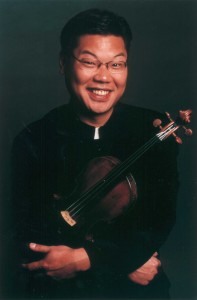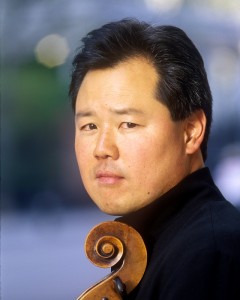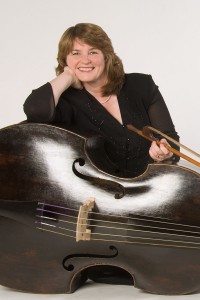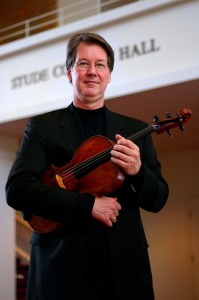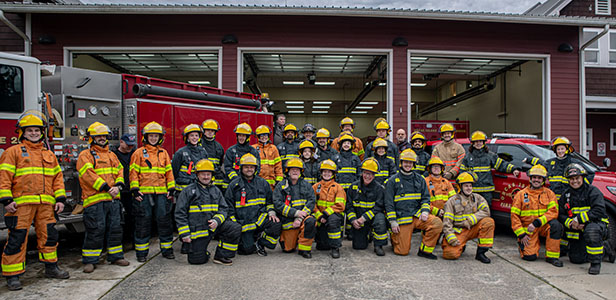The Orcas Island Chamber Music Festival opens this Friday, August 13 with “Duets Duos and Duels,” two concerts with performers including “two brothers, two pairs of spouses, two Canadians and two colleagues with 50 years of experience.”
It will be fun to consider these partnerships as the two brothers (Benny and Eric Kim), two pairs of spouses (Aloysia Friedmann and Jon Kimura Parker and Deborah and James Dunham), two Canadians (Parker and Martin Chalifour), and two colleagues (Arthur Grossman and William McColl) perform works by Glinka, Ravel, Glière, and Brahms on Friday and Saturday.
Maurice Ravel Sonata for Violin and Cello (Fourth Movement)
The Brothers Kim will perform Maurice Ravel’s Sonata for Violin and Cello. The fact that Benny and Eric Kim would only be free for the first concert dates, “drove an expansion of the festival,” said OICMF Founder and Artistic director Aloysia Friedmann. (This year, the festival will span two weekends, from Friday August 12 through Saturday, August 28.)
Benny Kim attended Juilliard School of Music at the same time as Aloysia. He now is professor of violin at the University of Missouri/Kansas City Conservatory of Music. He is “a passionate proponent of bringing the arts to … students at all levels, seniors” and other community groups, according to Jeff O’Kelly, OICMF program annotator. He is also a golf fanatic and a dog lover.
Eric Kim, cellist, made his solo debut at the age of 15 with the Chicago Symphony Orchestra and has been a featured soloist with many other symphony orchestras, including seats as Principal Cellist with the San Diego, Cincinnati, and Denver symphony. He too graduated from the Juilliard School and won the first William Schuman Prize for outstanding leadership and achievement in Music.
He is now Professor of Music at the Jacobs School of Music, Indiana University.
Ravel’s Sonata for Violin and Cello is commonly known as The Ravel Duo. It was first composed as a tribute to Debussy and then expanded into a multi-movement sonata. The fourth movement, to be performed in this concert, “is probably the most immediately attractive movement: with “jaunty rhythms and melodies,” (O’Kelly).
Ravel was born in a Basque town close to the border with Spain. His mother’s Basque/Spanish heritage was a strong influence on his life and music. His father was a Swiss inventor and industrialist;; among his inventions were an early internal-combustion engine and “a notorious “Circus” machine, the “Whirlwind of Death,” an automotive loop-the-loop that was quite a success until a fatal accident at the Ringling Bros. and Barnum & Bailey Circus,” according to Wikipedia.
At age seven, Maurice began piano lessons and received his first instruction in harmony, counterpoint, and composition. His father’s engineering influence exhibited itself in Ravel’s methodical study of the scores of past composers: he said, “in order to know one’s own craft, one must study the craft of others.”
Ravel was also influenced by the new Russian works, the impressionism of Claude Debussy and Spanish music; his synthesis of those elements is said to have matured into an “innovative and distinct style.” But his compositions generated a faint response and he failed to win required medals of recognition.
Ravel modeled his teaching methods after his own teacher Gabriel Fauré”, avoiding formulas and emphasizing individualism. Ravel’s preferred way of teaching would be to have a conversation with his students and demonstrate his points at the piano. He was rigorous and demanding in teaching counterpoint and fugue, as he revered Johann Sebastian Bach without reservation. But in all other areas, he considered Wolfgang Amadeus Mozart” the ideal, with the perfect balance between “classical symmetry and the element of surprise”, and with works of clarity, perfect craftsmanship, and measured amounts of lyricism. Often Ravel would challenge a student with “What would Mozart do?” then ask the student to invent his own solution
Around 1922, Ravel completed his famous orchestral arrangement of Modest Mussorgsky’s Pictures at an Exhibition, commissioned by Serge Koussevitzky, which through its widespread popularity brought Ravel great fame and substantial profit.
Mikhail Glinka Trio Pathétique in D minor
Lifelong colleagues Arthur Grossman and William McColl will revisit their performances as members of Soni Ventorum Wind Quintet and play the bassoon and clarinet, respectively in Glinka’s Trio Pathétique. Parker will accompany them on piano.
Both Grossman and McColl began their performance career at a young age; Grossman at 13 with the Oklahoma City Symphony Orchestra and the San Antonio Symphony, before beginning studies at the Curtis Institute of music; and McColl at the age of 12 with the National Music Camp at Interlochen and the Oberlin Conservatory of Music. Both have taught for many years at the University of Washington, and have international touring and extensive recordings to their credit.
Glinka’s Trio Pathétique is considered an unusual instrumental combination. Glinka was a sheltered youngster, which appears to have fostered a self-image of a semi-invalid. The only music he heard as a “sickly child” was the sounds of the village church bells and the folk songs of passing peasant choirs. The church bells were tuned to a dissonant chord and so his ears became used to strident harmony. Folksongs sung by his nurse provided and the songs performed by the traveling choirs used improvised dissonant harmonies below the melody, which is said to have influenced Glinka’s innovation “from the smooth progressions of Western harmony”
At the age of 10 Glinka was settled at his uncle’s home where he was able to hear his uncle’s orchestra, whose repertoire included pieces by Haydn, Mozart and Beethoven. He received instruction on the piano and violin, and when he left school his father wanted him to join the Foreign Office, where he was appointed assistant secretary of the Department of Public Highways.
The work was not demanding, which allowed him the time to compose his songs. On the advice of his doctor, travel to Italy followed, with the tenor Nikolay Ivanov. Although he spent three years in Italy listening to singers of the day, romancing women with his music, and meeting many famous people including Felix Mendelssohn and Hector Berlioz, he became disenchanted with Italy. He realized that his mission in life was to return to Russia to write in a Russian manner, and do for Russian music what Donizetti and Bellini had done for Italian music.” (Wikipedia)
Glinka was instructor of the Imperial Chapel Choir, with a yearly salary and lodging at the court. He composed two great operas, A Life for the Tsar (Ivan Susanin) and Ruslan and Lyudmila, whose overture is perhaps Glinka’s most well-known piece. He also composed the song that became the Russian National Anthem from 1990 to 2000.(Wikipedia)
Maurice Ravel Sonata for Violin and Piano
The “Duets” concert’s two Canadians are Vancouver native Jon Kimura Parker and Montreal native Martin Chalifour, violinist, who is the Principal Concertmaster of the Los Angeles Philharmonic, continues the “Concertmaster” tradition of OICMF’s visiting artists. (William Preucil from the Cleveland Symphony and Andrés Cárdenes, concertmaster of the Pittsburg Symphony have also been notable guests of the Festival in years past).
Chalifour attended the Montreal Conservatory and the Curtis Institute of Music. He received a Certificate of Honor at the 1986 Tchaikovsky Competition in Moscow and has performed as soloist and chamber music ensemblist internationally – including performances in New Zealand, Taiwan, Hong Kong and Malaysia. He now teaches at the University of Southern California’s Thornton School of Music.
Jon Kimura Parker was first taught and coached by his mother and his uncle in Vancouver, B.C., before attended Juilliard, where he received his doctorate in 1988. He was awarded Canada’s highest honor, the Order of Canada, in 1999.
In 1927, Ravel completed and premiered his Sonata for Violin and Piano, his last chamber work, with its second movement (titled “Blues”) gaining much attention.
The following year, Ravel made a four-month concert tour in North America, where he visited New Orleans. His admiration of American jazz, increased by his American visit, caused him to include some jazz elements in a few of his later compositions, especially the two piano concertos. The great success of his American tour made Ravel famous internationally.
After returning to France, Ravel composed his most famous and controversial orchestral work”Boléro,” originally called “Fandango”. Ravel called it “an experiment in a very special and limited direction”. He stated his idea for the piece, “I am going to try to repeat it a number of times on different orchestral levels but without any development.” He conceived of it as an accompaniment to a ballet and not as an orchestral piece as, in his own opinion, “it has no music in it”, and was somewhat taken aback by its popular success.
Glière / Proto Suite for viola and bass
The five-movement Suite for Viola and Bass, Op. 39 will be performed by one of the married couples: Deborah Dunham playing the bass, and James Dunham on viola.
Deborah studied the double bass at the Leopold Mozart Konservatorium in Augsburg, Germany and received a Master of Fine Arts degree from the California Institute of the Arts. She has toured internationally as a musician since 1981, maintained double bass teaching studios since 1991 and is currently on the faculty at Sam Houston State University’s School of Music. Her previous pre-college students have gone on to prestigious music schools at Rice University, Juilliard, Indiana University, Oberlin, Manhattan School of Music and Harvard University.
She serves as a principal bassist for Boston Baroque, Cantata Singers, Boston Modern Orchestra Project, Dinosaur Annex Contemporary Music Ensemble and Boston Cecilia. She has performed at many American music festivals including Aspen, Tanglewood, Grand Tetons, Mainly Mozart and, since 1993, plays annually as the solo bassist for the “Festival der Zukunft” in Switzerland. She has worked with the Rochester Philharmonic Orchestra, the Boston Symphony and Pops and Boston Orchestras, as well as serving as the Artistic Director of the Society for Chamber Music in Rochester.
Deborah is currently president of the Houston Chapter of the Viola da Gamba Society of America; and she is completing doctoral studies at Rice University’s Shepherd School of Music as a member of Paul Ellison’s studio.
James Dunham is currently Professor of Viola and Chamber Music at Rice University’s Shepherd school of Music, where he directs the Advance Quartet Studies Program. He has taught at the New England Conservatory, and played with the Cleveland Quartet and collaborated with members of the American, Guarneri, Juilliard, Takacs and Tokyo Quartets.
He is much sought after as a jurist for events such as the Fischoff, Coleman and William Primrose Competitions, and has also been a featured soloist at the International Viola Congress. His summer activities include teaching and performing at many festivals, including those of Marlboro, Domaine Forget, Aspen, Sarasota, Amelia Island (FL), Yale at Norfolk and Musicorda. He served as principal violist of the San Diego Mainly Mozart Festival for ten seasons, and is a regular participant in the Festival der Zukunft in Ernen, Switzerland.
James and Debra Dunham suggested the Glière composition, “Suite for Viola and Bass” to Artistic Director Alyosia Friedmann. Composer Reinhold Glière was the second son of the wind instrument maker He was born in Kiev of German-Polish descent. At the age of 16 he entered the Kiev school of music and advanced three years later to the Moscow Conservatory where he studied counterpoint, composition, violin and Harmony. He graduated in 1900, having composed a one-act Opera ‘Earth and Heaven’ (after George Gordon Byron) and received a gold medal in composition.
Through the tumultuous years of the Bolshevik Revolution and the founding of the Union of the Soviet Socialist Republics (USSR), Glière taught (both Nikolai Myaskovsky and the eleven-year old Sergei Prokofiev were among his students), conducted, composed and performed without offending the political sensibilities of the authorities.
He composed the opera Shakh-Senem, now considered the cornerstone of the Soviet-Azerbaijan national opera tradition, where the “musical legacy of the Russian classics from Glinka to Scriabin is combined with folk song material and some symphonic orientalisms. In 1927, inspired by the ballerina “Yekaterina Vasilievna Geltser , he wrote the music for the ballet Krasny mak (The Red Poppy), later revised, to avoid the connotation of opium, as Krasny tsvetok (The Red Flower, 1955). The Red Poppy was praised ‘as the first Soviet ballet on a revolutionary subject’” The “Sailor Dance” is perhaps most well-known to Western audiences.(Wikipedia).
Brahms Piano Quartet in A Major
“When I knew the Kims were coming, I really wanted to program the Brahms,” said Aloysia. “It’s a major, major, really magnificent work for piano and strings.” The Brahms Piano Quartet will feature the second “spousal unit” at the concerts: Aloysia and husband Jon Kimura (Jackie) Parker, as well as the Kim brothers.
Aloysia and Jackie are both from the Pacific Northwest and met at Juilliard Music School in New York City. A courtship of 14 years followed, during which Jackie was lured to Orcas Island, where Aloysia’s parents, violinist Martin Friedmann and oboist Laila Storch (co-founder of Soni Ventorum) have long had a home.
Although Jackie has described their courtship as “somewhat in the vein of Rome and Juliet, as she was pretty straight and I was ‘more colorful,’” after the first two-day Orcas Island Chamber Music Festival in 1998, Aloysia and Jackie were married. Their honeymoon included a Festival board meeting on Crane Island.
Aloysia studied viola with her father and Emanuel Zetlin before attending Juilliard. She has performed in New York City with rock’n’roll and Broadway productions. She has toured internationally with symphonic ensembles and produced and performed on many recordings. She is a founding member of the San Diego Mainly Mozart Festival and performs with the Houston Grand Opera orchestra.
As well as the Artistic Advisor for the OICMF, Jackie Parker teaches at the Shepherd School of Music at Rice University and has given master classes at the Banff Centre and Juilliard School, among other institutions. He is a versatile performer, having played with Bobby McFerrin, Doc Severinsen, Audra McDonald and the Mormon Tabernacle Choir.
The Brahms Quartet for Piano and Strings in A Major is in four movements, was begun in 1855, when Brahms was 22 years old. It was completed after he moved from his parents Hamburg home at the age of 27, into a home owned by the friend of members of a women’s choir he was directly at the time.” (O’Kelly).
O’Kelly describes the first movements as fiery, and gypsy-flavored. He calls the second movement “a masterpiece within a masterpiece,” beginning “with the character of a lullaby,” that grows increasingly more complex and passionate into “one of Brahms’ most immediately arresting and unique creations.”
The third movement is characterized by O’Kelly as proceeding from “flowing” to “chattering.” The fourth movement presents “rhythmic exuberance with a Slavonic flavor.”
O’Kelly continues, “At times, this movement rises to heights of symphonic grandeur before the animate coda brings the proceedings to a joyous conclusion.”
Johannes Brahms conducted choirs from his early teens, and became a proficient choral and orchestral conductor. He composed for piano, chamber ensembles, symphony orchestra, and for voice and chorus. A virtuoso pianist, he gave the first performance of many of his own works; he also worked with the leading performers of his time, including the pianist Clara Schumann.
He has been described as an uncompromising perfectionist, and is known to have destroyed many of his works and left some of them unpublished. He adhered strictly to the principles of counterpoint, “the complex and highly disciplined method of composition for which Bach is famous, and also of development, a compositional ethos pioneered by Haydn, Mozart and Beethoven. Brahms aimed to honor the “purity” of these venerable “German” structures and advance them into a Romantic idiom, in the process creating bold new approaches to harmony and melody. (Wikipedia)
“His works were labeled old-fashioned by the ‘New German School’ whose principal figures included Liszt and Richard Wagner. Brahms admired some of Wagner’s music and admired Liszt as a great pianist, but the conflict between the two schools, known as the “War of the Romantics,” soon embroiled all of musical Europe.” (Wikipedia)
The Brahms Piano Quartet in A Major will be the finale of the “Duets, Duos and Duels” concerts at the Orcas Center on Friday, August 13 and Saturday, August 14. The Aug. 13 performance is sponsored by Phyllis and Robert Henigson, with the reception provided by Barbara and Eric Gourley. The Aug. 14 performance is sponsored by Margie and Daniel Carper; the reception following in provided by Catherine and Steve Henderson.
Tickets may be purchased at www.oicmf.org or by calling 360-376-6636 or toll-free at 866-492-0003.
Waiting List policy
OICMF Executive Director Victoria Parker says, “A very productive waiting list is offered for each concert (with the exception of the Children’s Concert). When tickets become available through returns or traded nights, staff will call those on the Waiting List in the order of their inclusion. Every reasonable effort will be made to contact those on the list. Approximately 30 minutes before a concert begins, the waiting list will be abandoned and hopeful patrons waiting in the lobby will be offered any tickets that are still available. Seats that are not occupied by Intermission will be resold at a reduced price.”
**If you are reading theOrcasonian for free, thank your fellow islanders. If you would like to support theOrcasonian CLICK HERE to set your modestly-priced, voluntary subscription. Otherwise, no worries; we’re happy to share with you.**

